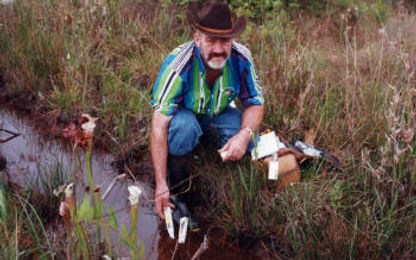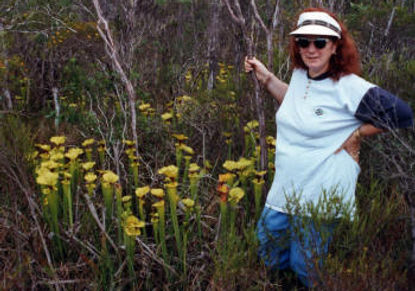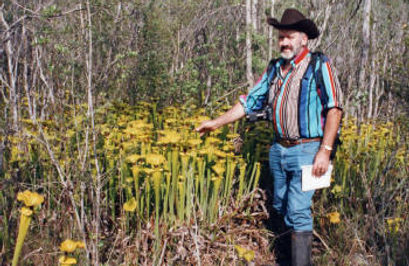Leading Australian grower and supplier of Carnivorous Plants and Water Plants.

Our Mail Order sales are now closed until Saturday 17th January 2026.
We wish all of our customers a very Merry Christmas and a safe and Happy New Year.
Please visit our Mail Ordering Conditions
page for more info.
THE FIRST INTERNATIONAL CARNIVOROUS PLANT SOCIETY CONFERENCE
By Colin and Tina Clayton
of Triffid Park
ATLANTA, U.S.A.



We had arrived in Atlanta, Georgia at the Atlanta Botanical Garden, the site of the first International Carnivorous Plant Convention which was held from 16th - 20th May, 1997, and what a Conference it was to be.
The scene was set on Thursday evening, 15th May, when, after registering, we were treated to a magnificent open air buffet dinner in the immaculately manicured grounds of the Atlanta Botanical Garden.
Next morning a veritable who’s who of the Carnivorous Plant world assembled. They had come from all over the United States, Japan, England, France, Sabah (Borneo) and Australia. Never before had so many Carnivorous Plant personalities gathered in one place at one time. The lectures (accompanied by slide shows) were given by the following people over the next three days:
Ron Determann, Superintendent, The Dorothy Chapman Fuqua Conservatory, Atlanta Botanical Garden
Ms. Nora Murdoch, USFWS, USA
Ms. Cary Norquist, USFWS, USA
Leo Song, ICPS, California, USA
Joe Mazrimas, ICPS, California, USA
Cliff Dodd, Florida, USA
Peter D’Amato, California Carnivores, USA
Professor Katsuhiko Kondo, Hiroshima University, Japan
Ron Gagliardo, Tissue Culture Laboratory, Atlanta Botanical Garden
Dr. Thomas Gibson, University of Wisconsin-Madison, USA
Dr. Larry Mellichamp, UNCC, North Carolina, USA
Ms. Sharon Hermann, Tall Timbers Inc, Florida, USA
Mike Rinck, Agristarts, Florida, USA
Ms. Madeleine Groves, Royal Botanical Garden, Kew, UK
Dr. Martin Cheek, Royal Botanical Garden, Kew, UK
Ms. Rimi Repin, Sabah Parks, Sabah
Rob Naczi, Northern Kentucky University, Kentucky, USA
Phil Sheridan, Woodford, Virginia, USA
Rick Walker, President, ICPS, California, USA
Michael Szesze, Maryland, USA
This was followed by a video by Thomas Carow from Nudlingen, Germany.
Before we went to the Conference we wondered how the Speakers would be able to find enough different subjects to talk about to fill in the allotted three days. But they did, and each lecture was just as enthralling as the last. Most of the Speakers could have used far more time, as how, in 45 minutes, could they impart upon us the knowledge acquired in a lifetime of labour and love? So much knowledge, and so little time to listen to the famous people who, up to now, had only been faceless names at the end of articles in International Journals. All too soon the first International Carnivorous Plant Conference came to an end.
But for 42 adventurers the excitement was just beginning, for we had elected to do a two day post conference tour of some of the local carnivorous plant “bogs”.
Ron Determann, Ron Gagliardo and Madeleine Groves were to be our Guides. We left the Atlanta Botanical Garden at 7 in the morning for what turned out to be a 6 hour drive into Florida (did I say local bogs?).
The first stop looked, at a casual glance, like a thousand other spots we had passed that day. However, this one was definitely different. When we got out of our vehicles we couldn’t believe our eyes. There were so many different carnivorous plants growing right beside the road. We were told that although this small bog contained carnivorous plants that were endemic to this area, sometime in the past 40 or 50 years someone had planted Dionaea muscipula here. Although they did not naturally grow this far south they were thriving, and now there were thousands of them everywhere, their white flowers standing out quite plainly above the surrounding grasses. Although this bog only covered an area of about 2 or 3 house blocks, we counted 8 different carnivorous plant species here. As this was to be our only sighting of Fly Traps on this trip, hundreds of photos were taken.
Next stop was at a huge area which had been deliberately burnt. This is called an ecological burn, and it helps to restore the natural balance of plant life in the area. It had not been burnt long ago, for ashes were still thick on the ground. However Pinguicula planifolia had already grown 3 or 4 new leaves - and to think how we baby these plants!
The home of Sarracenia purpurea and Sarracenia psittacina was our next discovery. These grew best where the Roads Department had mowed the grass on the edge of the road. It had been mowed approximately 3 or 4 inches high, and although occasionally the tops of the S. purpurea had been scalped, they were thriving. Our party soon spread itself along the roadside finding many natural Sarracenia hybrids. The cries of “come and look at this one” or “WOW this is the best yet”, had to go unheeded, as there were just too many to look at.
Late in the afternoon we pulled up at a clearing of about 20 or 30 acres. On the far side was a low sparse line of pine trees and bushes. We walked across to this, and were greeted with the most amazing spectacle. For here, hidden in these bushes were thousands of Sarracenia flava. Words fail to describe how perfect they were, all standing straight and tall with each pitcher completely undamaged. Amongst all of these were some fascinating color variations, including one completely red one. Yes, the lid, throat and tube were entirely red. It was worth the entire trip just to witness this one plant. There were so many plants here, and the site was so vast, that we could not even begin to explore it in the allotted time. So sadly we all piled into our little convoy of 9 cars and 3 mini-buses for a 3 hour drive, which turned dark and wet, to our dinner and night’s accommodation in Pensicola, Florida.
Our final destination on this Field Trip next morning was to be Bob Hanrahan’s private 40 acre carnivorous plant preserve in Elsanore, Alabama, a short drive from Pensicola. When Bob purchased his property 12 years ago it already contained a very large population of carnivorous plants, including literally acres of Sarracenia leucophylla. These plants were thriving here, and what a site they were! For to stand in a field of 10’s of 1,000’s of leucophyllas waving in the breeze, was a memory Tina and I will never forget.
Bob (who by the way is the Proprietor of World Insectivorous Plants) had instigated an interesting project. He was field planting 1,000’s of seed raised carnivorous plants of many genera on his property. They had acclimatised well and were now producing their own hybrids. The most stunning one was a cross between Sarracenia leucophylla and a red-tubed Sarracenia flava. And what a plant this was! It would have taken pride of place in the most ardent connoisseur’s collection.
This was indeed a most fitting place to end the first International Carnivorous Plant Conference.

Colin testing the ph for growing carnivorous plants
on Bob Hanrahan's property.

Tina in a field of Sarracenia leucophylla's on Bob Hanrahan's property at Elsanore, Baldwin County, Alabama, U.S.A.

Colin in a field of red tubed Sarracenia flavas - Savannah Apalachicola National Park, Florida, U.S.A.

Tina amongst Sarracenia flava f. cut throat in a "Burnt Bog", Sumatra in the Apalachicola National Park, Florida, U.S.A.

